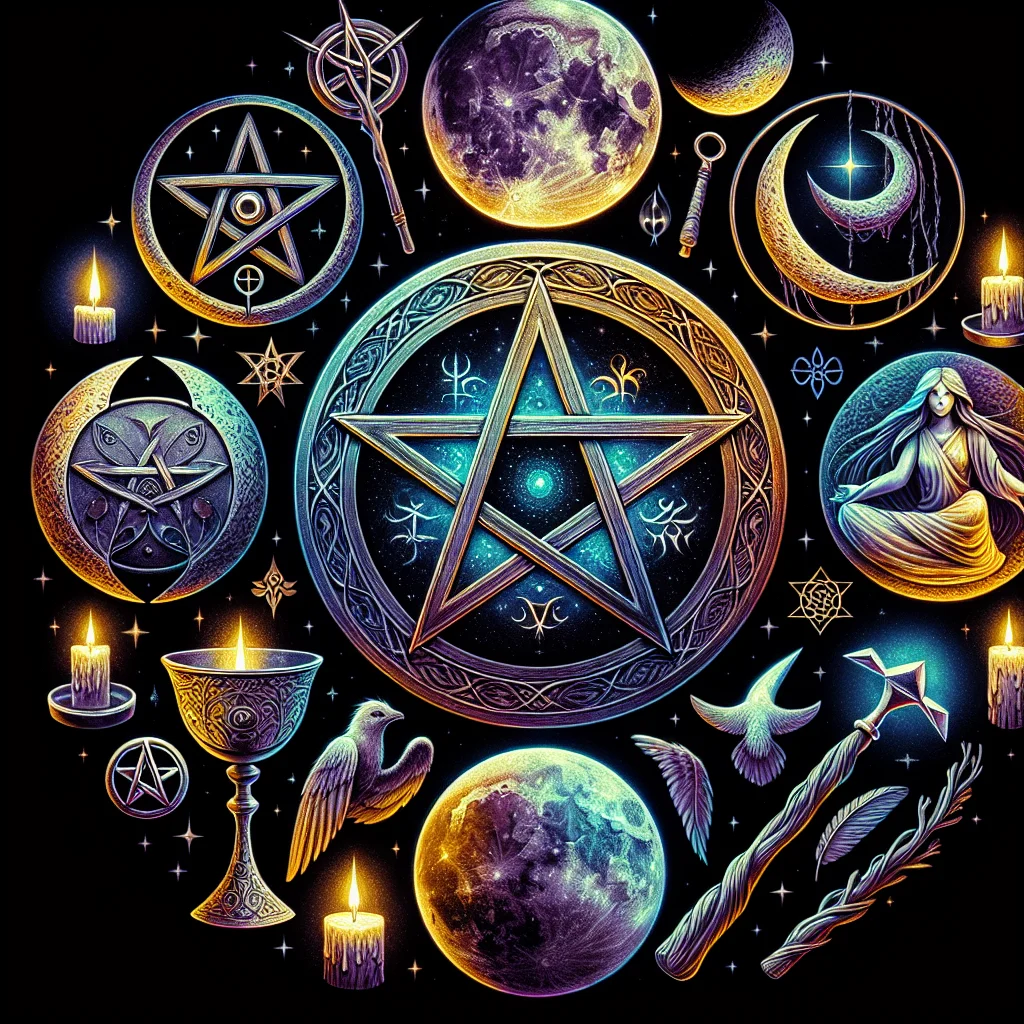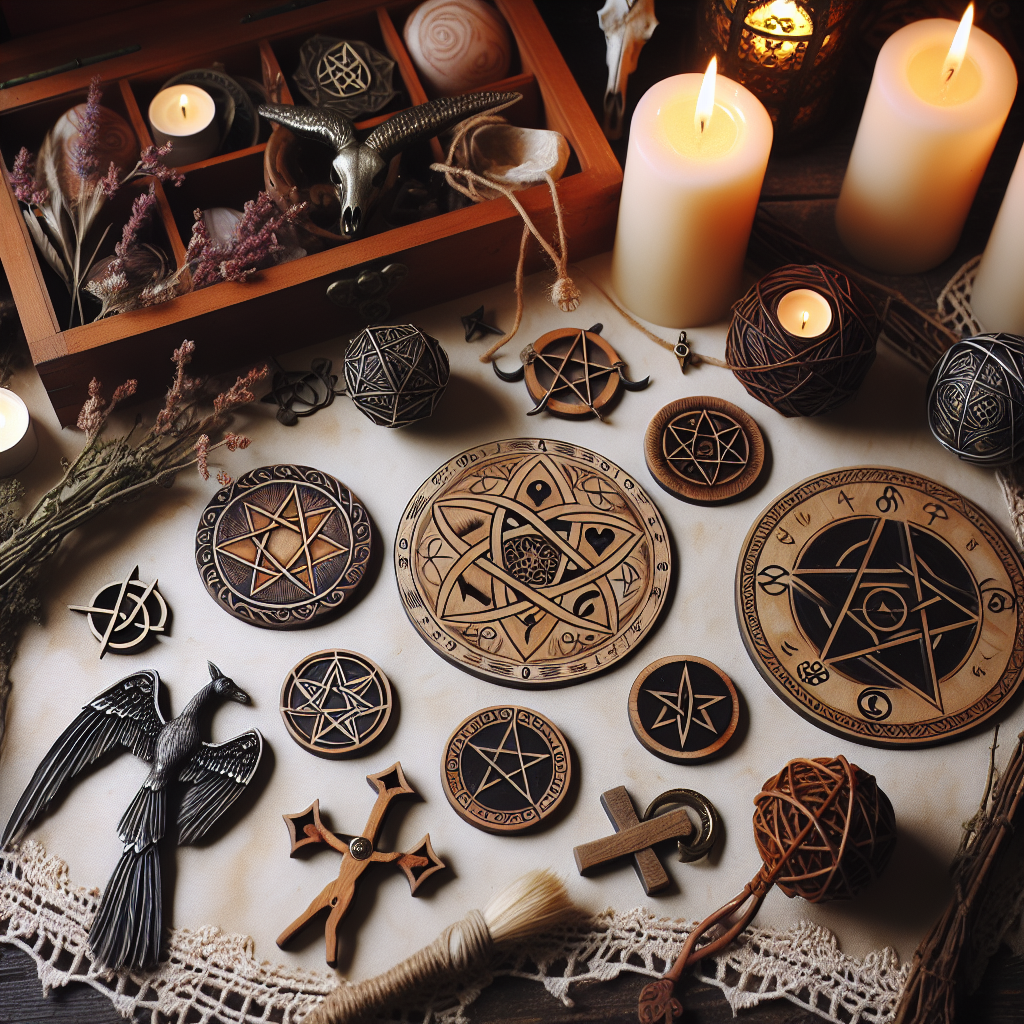As an Amazon Associate I earn from qualifying purchases.

Wicca, often termed as “the Craft” or “Witchcraft,” is a modern Pagan religion that has been rapidly gaining followers since its inception in the first half of the 20th century. Among its core aspects are the rich symbols that play a fundamental role in rituals and beliefs. Like the language of the unconscious mind, these symbols are a silent dialogue, a code through which practitioners connect with the divine and the forces of nature.
The roots of Wiccan symbols stretch back to pre-Christian traditions and ancient pagan cultures. The practice of Wicca itself was introduced to the public in the 1950s by Gerald Gardner, a retired British civil servant who claimed that he was initiated into a coven of witches in the New Forest region of England. Gardner, and others who followed, blended elements of folklore, medieval occultism, and ceremonial magic with modern esoteric theories, thereby crafting a distinct symbology deeply steeped in meaning and purpose.
One of the most emblematic symbols within Wicca is the pentacle or pentagram—a five-pointed star often enclosed within a circle. Traditionally, each of the five points represents an element—earth, air, fire, water, and spirit—with the circle symbolizing the interconnectedness and unity of all things. This potent symbol serves as a protective sigil and a tool for channeling magical energies. Its use in Wiccan practice underscores a respect for the balance of nature and the interconnectedness of all living things.
Another central symbol is the Triple Goddess, represented by a waxing, full, and waning moon conjoined. This motif honors the divine feminine and reflects the threefold nature of the Goddess as maiden, mother, and crone. Each phase correlates with aspects of the female experience and the natural cycles of life and death. The association of the divine with cycles found in nature is a powerful statement of the religion’s reverence for the natural world and its rhythms.
Furthermore, the presence of Wiccan symbols in modern culture is not insignificant; symbols such as the triquetra and the spiral have seen a boost in popular culture visibility. The triquetra, a three-cornered Celtic knot, is understood in Wicca to signify the interconnectedness of mind, body, and soul, as well as the threefold nature of the Goddess. This symbol can be seen adorning jewelry, books, and various forms of media, indicating wider recognition of Wiccan practices and symbology beyond its community of practitioners.
Equally captivating is the statistic that suggests the number of Wiccans in the United States had shown remarkable growth in recent years, with some surveys estimating numbers into the hundreds of thousands. This rise reflects not only the growing appeal of Wiccan spirituality but also the inherent human quest for a connection with something greater than oneself—often found in the exploration of mystical paths and the embracing of ancient symbols. In the age of relentless rationalism and technology, Wiccan symbols serve as a bridge to the enigmatic and the spiritual, providing a medium through which modern seekers can discover meaning and enchantment.
“`html
What Do Wiccan Symbols Mean? Unlocking the Secrets of Pagan Icons
“`
Wiccan symbols are a collection of icons and sigils that hold profound spiritual significance within the Wiccan and wider Pagan community. These symbols encapsulate core principles, deities, and elements of the natural world that are central to Wiccan practice. They serve as tools for ritual, meditation, and as reminders of the faith's underlying philosophies. From the pentacle, representing the five elements and human spirit, to the triple moon symbolizing the Goddess's three aspects, each icon is imbued with energy and intention. Understanding the meanings behind these symbols not only deepens one's connection to Wicca but also enhances the practice of magic and the personal spiritual journey. Dive into the full discussion below to explore each symbol's history, meaning, and application within the Wiccan tradition.
Wiccan symbols hold profound meaning and are integral to the practice of Wicca, a nature-based, polytheistic religion that also incorporates elements of paganism and witchcraft. Each symbol serves as a focal point for rituals, carries metaphysical energies, and represents the beliefs and deities within the Wiccan tradition. Here, we'll explore the most prominent Wiccan symbols and their significance to better understand the nuanced beliefs and practices within Wicca.
**The Pentacle or Pentagram**
Arguably the most recognized among Wiccan symbols is the pentacle, a five-pointed star encased within a circle. When the single point faces upwards, it represents spirit presiding over the four elements of earth, air, fire, and water. This aligns with the Wiccan Law of Five, signifying balance and harmony within nature and the self. The pentacle is often used in rituals for protection, channeling energy, and grounding practitioners in their magical work.
**The Triple Moon**
The Triple Moon symbol combines the waxing, full, and waning moon phases, depicting the aspects of the Goddess as the Maiden, Mother, and Crone. This symbol epitomizes the cycle of birth, life, death, and rebirth, and the eternal nature of the divine feminine. It stands for wisdom, growth, and the fluid nature of time and existence.
**The Horned God**
As a counterpart to the feminine divine, the Horned God symbol, which often features a crescent moon or horns, represents masculinity, fertility, and the wilderness. This deity is commonly associated with nature, animals, and the life cycle. The Horned God is worshipped during Sabbats and is considered the male force of the universe, complementing the Goddess.
**The Spiral Goddess**
The Spiral Goddess symbol, a figurine marked with a spiral on the belly, is a sign of the life-giving power of the Goddess and the womb from which all life springs. The spiral itself represents the never-ending cycle of life, death, and rebirth, as well as the unfolding of the human consciousness, personal evolution, and the mysteries of the universe.
**The Ankh**
Though originally an ancient Egyptian hieroglyph, the Ankh has been adopted into Wiccan tradition and symbolizes life and the zest for existence. It's often seen as a key to unlocking the gates of death, leading to immortality and the eternal. The Ankh is a testament to the connection between early pagan beliefs and modern Wiccan practices.
**The Green Man**
The Green Iman appears often in Wiccan art and symbology, depicting a face surrounded by or composed of leaves. This figure is synonymous with the natural world, the cycle of growth each spring, and man's affinity with the earth. The Green Man also represents rebirth and the renewing quality of nature.
**Principles of Magical Correspondences**
In Wiccan practice, symbols hold power because they are part of a larger system of magical correspondences. This system links symbols, intentions, and natural forces, allowing practitioners to channel desired energies and manifest intention during rituals. Wiccans often employ candle colors, herbs, stones, and planetary alignments in combination with symbols to enhance their effectiveness.
Understanding these symbols provides not just an insight into Wiccan rituals and beliefs but also the rich tapestry of Wicca's theological foundation and cosmology. The practice of using these symbols is deeply personal and subjective within the Wiccan community, varying from one practitioner to another.
A statistic that may interest those exploring Wiccan symbols is that Wicca has seen a steady increase in followers over the years. According to the Pew Research Center, as of 2014, 0.4% of Americans, or about 1 to 1.5 million people, identify as Wiccan or Pagan, highlighting the growth and continued relevance of these ancient symbols in contemporary spiritual practices.
“`html
- What is the significance of the pentacle in Wicca?
The pentacle is one of the most recognized Wiccan symbols, often representing the five elements (earth, air, fire, water, and spirit) and the interconnectedness of all life. It's used as a protective symbol and for channeling energy in rituals.
- Can anyone use Wiccan symbols, or are they exclusive to practitioners?
While Wiccan symbols are sacred to practitioners, they can be used by anyone who feels a connection to their meanings and respects their significance. However, it's important to understand each symbol's meaning and to use them respectfully.
- Is the triple moon symbol only associated with the Goddess?
The triple moon symbol represents the three phases of the moon—waxing, full, and waning—which correlate to the Triple Goddess's aspects in Wicca: the Maiden, the Mother, and the Crone. It's a powerful symbol of the feminine divine and the life cycle.
- What does the symbol of the Horned God represent?
The symbol of the Horned God encompasses masculinity, fertility, the wilderness, and the life force. It typically features a circle with a crescent moon on top, evoking the image of a horned deity.
- Are Wiccan symbols safe to use in daily life, or are they just for rituals?
Wiccan symbols can be incorporated into daily life as talismans or reminders of spiritual principles. They're not limited to ritual use and many people wear symbol-inspired jewelry or carry items for protection and guidance.
- How can I properly dispose of an object with a Wiccan symbol if I no longer wish to keep it?
To dispose of an object with a Wiccan symbol, do so with respect and gratitude. Some choose to bury it, return it to nature, or pass it on to another practitioner. If it's made of paper, it can be burned, signifying a release of its energy back into the universe.
- Is the Ankh a Wiccan symbol, and what does it mean?
The Ankh, though originally an ancient Egyptian symbol for life and immortality, has been adopted by some Wiccan traditions. It symbolizes life, the universe, and the union of feminine and masculine energy.
- Does the use of Wiccan symbols require a certain level of experience or initiation?
While some Wiccan paths might have specific guidelines for using symbols, in general, they can be used by anyone who has studied their meanings and feels called to work with them, regardless of experience or initiation level.
- What is the best way to integrate Wiccan symbols into my practice?
The best way to integrate Wiccan symbols into your practice is to learn about their meanings, correspondences, and uses. Start by incorporating symbols that resonate with you into your rituals, altar, or daily life, and remember to use them with intention and reverence.
- How can I ensure that I'm respectfully using Wiccan symbols in my artwork or products?
To respectfully use Wiccan symbols in artwork or products, educate yourself about their meanings and significance within the Wiccan faith. Give credit where it's due and avoid commercializing or trivializing sacred symbols. Seek guidance from the Wiccan community if unsure.
“`
Conclusion
Through exploring the rich tapestry of Wiccan symbols, we gain insight into the core beliefs and practices that define this spiritual path. Symbols such as the pentacle, Triple Moon, and Wheel of the Year serve not only as representations of the divine and the natural world, but also as powerful tools for meditation, magic, and ritual. Each symbol is imbued with a deep symbolic meaning, connecting Wiccans to the energies of the earth, the cycles of the moon, and the elements. By understanding these symbols, one can appreciate the interconnectedness of all life and the reverence for nature that is central to Wiccan spirituality.
Moreover, the article has elucidated the ways in which these symbols can be used in daily practices to enhance spiritual awareness and foster a sense of unity with the cosmos. Wiccan symbols act as a language of the soul, a means for the practitioners to express their beliefs and intentions, and to manifest their desires into reality. Whether it be through the crafting of a personal altar, the celebration of Sabbats and Esbats, or the casting of a circle, these symbols are integral to the fabric of Wiccan practice, ensuring that the wisdom of the ancients is preserved and continues to thrive in the hearts of modern followers.
Amazon and the Amazon logo are trademarks of Amazon.com, Inc, or its affiliates.


